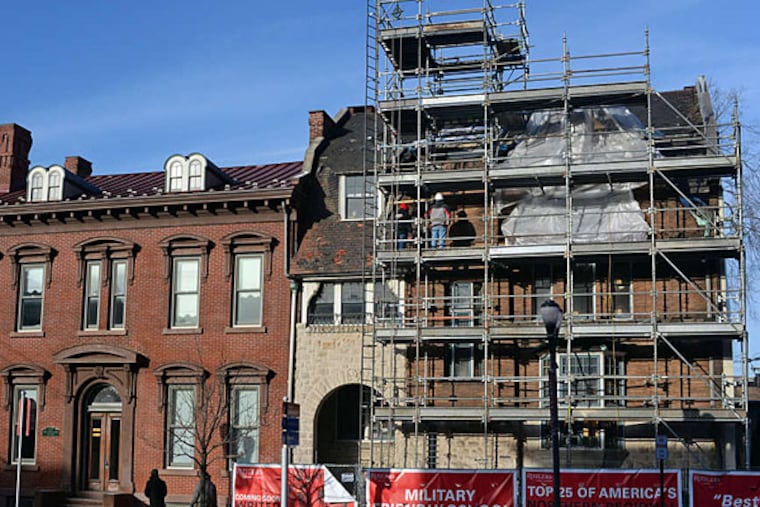At Rutgers-Camden, a new Writers House in the works
A historic Camden townhouse that was home to a prominent Camden doctor will again be filled with life and learning when Rutgers University students and faculty move in to their new Writers House.

A historic Camden townhouse that was home to a prominent Camden doctor will again be filled with life and learning when Rutgers University students and faculty move in to their new Writers House.
The Henry Genet Taylor House, undergoing renovations at 305 Cooper St., will open next academic year as the home of Rutgers-Camden's graduate programs in English, with space for classes, workshops, offices, and public events.
"This building is a gem - maybe one of the best of its type in the region - and I do think it has got to be more inspirational than sitting around chipped, cramped classroom desks in a 1960s building," Lisa Zeidner, an English professor at Rutgers-Camden and a novelist, wrote in an e-mail.
With attic and basement space reserved for storage, the usable space will consist of 4,670 square feet over three floors: six rooms of office space, two large seminar rooms, two small seminar rooms, a lounge, a small meeting room, and a reading room.
"I was impressed with how carefully the architects went about renovating the spaces to respect the historical record, while still trying to make the spaces modern in utility and inviting," Zeidner wrote.
Designed by the esteemed Philadelphia architect Wilson Eyre Jr. in 1884 and completed shortly afterward, the house originally served as primary residence and as office space for Taylor, who founded Camden's first hospital. The building was added to the National Register of Historic Places in 1989.
"The Dr. Taylor House is one of the most distinguished extant attached townhouses of the American Queen Anne Revival style in the nation, and probably was one of the best of the early urban works of its architect," the Camden County Historical Society wrote in a 1971 nomination to the National Register.
Today, Rutgers-Camden is finishing interior demolition while refurbishing original fixtures - fireplace mantels, lights - that will keep the historic nature of the house intact and lend presence to the space. The project's entire cost is being borne by a $4.25 million state grant.
"I love that it's historic, I really do. I think we are so lucky. And it's also a reminder of what Camden has been in the past: a place where beautiful buildings thrive. And now we get one of our own," said Lauren Grodstein, a novelist who heads the master of fine arts program in creative writing.
"It kind of elevates the work you're doing," she said. "It feels special, and it honors the work that we do."
Most of the features in the new space will be original to the house, though they may be rearranged to fit the new layout, said Angelo Flamini, the project manager overseeing the work. A sunroom that was not original to the home will be removed, he said, and a fireplace that was in the sunroom will be moved elsewhere in the building.
The goal, Flamini said, is to be as true to the home's history as possible.
"It's going to be extremely beautiful," said Ellen Malenas Ledoux, who oversees Rutgers-Camden's master's program in English.
The Writers House will give that program and the graduate creative-writing program a central location for classes, Ledoux said. Faculty will continue to be based in offices at Armitage Hall across campus, but the school hopes to build office space nearby in the future.
Classes are currently scattered across campus, and events such as visiting writers' talks or community workshops are fit into the jigsaw puzzle of available campus spaces.
With one location for classes and lounge space, Ledoux said, students will be able to interact more often in informal ways.
"I know that sounds silly, but the idea of the informal space . . . is actually really important," Ledoux said, citing career work that takes place outside classes and graduate student groups that have no space of their own.
"Just having that sense of community, a lot of relationships are built that way, right?" she said. "Right now we have had people scattered all over, and that doesn't allow for that kind of organic networking to occur."
The Writers House also will help brand the creative-writing and English programs at Rutgers-Camden, Grodstein said, and not just for visiting writers and speakers. The school's civic engagement mission means the Writers House is for a broader, nonacademic community as well. To that end, Grodstein says she plans to develop noncredit community writing classes based in the new building.
The goal, she said, is to "extend our community outward so that it's not just on Cooper Street, but rather throughout all of South Jersey and maybe across the river."
"People who love to read and write in Camden now have a new place to celebrate those things," she said.